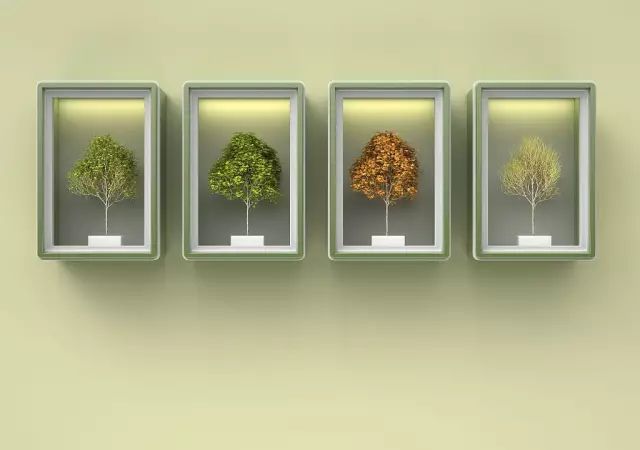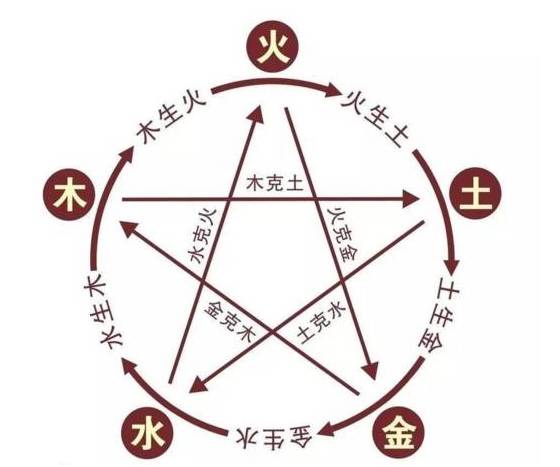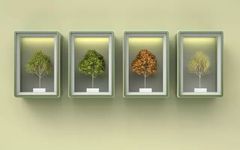From the observation of phenology, spring is characterized by the expansion of Qi, which controls or dominates the life activities in nature, hence it is named “Wood” Qi; summer is characterized by the rising movement of Qi, which controls or dominates life activities, hence it is named “Fire” Qi.
Autumn is characterized by the inward gathering movement of Qi, which controls or dominates life activities, hence it is named “Metal” Qi; winter is characterized by the descending movement of Qi, which controls or dominates life activities, hence it is named “Water” Qi; and the long summer is characterized by the stable movement of Qi, which controls or dominates life activities, hence it is named “Earth” Qi.
The Five Elements interact in a seasonal order, supporting and nurturing each other, which is called the mutual generation of the Five Elements; they also restrain and suppress each other in a seasonal order, which is called the mutual overcoming of the Five Elements. The mutual generation prevents any element from being deficient, while the mutual overcoming prevents any element from being excessive, thus ensuring a stable state of Qi transformation throughout the year.
According to the Huangdi Neijing, the Five Elements are placed alongside Yin and Yang, both considered the source of life. The theory of the Five Elements is an ancient scientific theory that studies the movement and transformation of Qi in nature, as well as the origins and laws of life.
The Five Elements are one of the important contents of TCM theory. Based on the records in the Huangdi Neijing and other ancient texts, the author discusses the basic concepts of the Five Elements from the perspective of Qi movement.
1
The Five Elements are not merely five materials.
The Five Elements reveal the laws of Qi movement and transformation between heaven and earth, the intrinsic connection between humans and nature, and the characteristics and interconnections of Qi in various organs of the human body.
In the theory of the Five Elements, the five characters: Wood, Fire, Earth, Metal, and Water have transcended their original meanings as five specific materials to represent five forms of Qi movement, rising from a material level to a metaphysical level that studies the universal laws of all things, thus moving from the level of “objects” to the level of “principles”.
The so-called Five Elements refer to Wood, Fire, Earth, Metal, and Water.
However, if understood literally as five specific materials, they can only be called five materials, not five elements. The concept of “five materials” has existed since ancient times. In the Zuo Zhuan, it states: “Heaven produces five materials, and the people use them together; one cannot be discarded.” The Shang Shu Da Zhuan also records: “Water and fire are what the people consume; metal and wood are what the people use for work; earth is what nourishes all things, and is for human use.” This refers to five materials, five specific substances and materials. Even if referred to as five elements, it still falls under the category of five materials.
The character “行” (xing) in Five Elements, as explained in the Shuo Wen Jie Zi, means: “the steps of a person”, which refers to walking, and can be extended to mean action, movement, or operation.
The so-called “Five Elements” should refer to the five forms of Qi movement in nature, or five forms of movement.
The Bai Hu Tong from the Han Dynasty states: “The term ‘movement’ refers to the movement of Qi in heaven.” This means that the term “movement” is used to describe the movement and operation of Qi in nature. Dong Zhongshu from the Han Dynasty stated more clearly in the Chunqiu Fanlu: “The Qi of heaven and earth combines into one, divides into Yin and Yang, distinguishes into four seasons, and categorizes into five elements.”
Movement varies, hence there are five elements. They mutually generate and overcome each other. It is clear that the Five Elements refer to the movement of Qi between heaven and earth; with Yin and Yang, there are four seasons, and with four seasons, there are five elements. The reason for using the term “movement” is that the movement of Qi between heaven and earth varies.
The Five Elements interact in a seasonal order, generating and overcoming each other, which is called mutual generation and mutual overcoming. The Suwen states: “Heaven has four seasons and five elements, for growth, storage, cold, heat, humidity, dryness, and wind.” This also connects the four seasons with the Five Elements. Therefore, in the Huangdi Neijing, the Five Elements are also referred to as “Five Movements”.
These all illustrate that the Five Elements reveal the laws of Qi movement and transformation between heaven and earth, the intrinsic connection between humans and nature, and the characteristics and interconnections of Qi in various organs of the human body.
Thus, in the theory of the Five Elements, the five characters: Wood, Fire, Earth, Metal, and Water have transcended their original meanings as five specific materials to represent five forms of Qi movement, rising from a material level to a metaphysical level that studies the universal laws of all things, thus moving from the level of “objects” to the level of “principles”.

2
The Attributes and Classifications of the Five Elements
With the rotation of the heavens and the changing of the seasons on the ground, the Qi of nature undergoes orderly movements and changes: expansion, rising, stability, inward gathering, and descending. The ancients used Wood, Fire, Earth, Metal, and Water to represent their movement characteristics, which is called the Five Elements.
What are the forms and characteristics of Qi movement represented by the Five Elements? What is the basis for classifying all things in nature using the Five Elements? The ancients studied this using the method of “observing the heavens and examining the earth, knowing human affairs in between.”
Due to the rotation and revolution of the Earth, the ancestors living in the Northern Hemisphere could easily observe the daily and annual movements of the Big Dipper when looking up at the starry sky in the evening.
Regarding the annual movement, when the handle of the Big Dipper points east in the evening, it corresponds to spring; when it points south, it corresponds to summer; when it points west, it corresponds to autumn; and when it points north, it corresponds to winter.
This is the origin of the correspondence between the four directions and the four seasons.
In the Shang Han Lun, Zhang Zhongjing recorded the relationship between the direction of the Big Dipper’s handle and the four seasons, eight major solar terms (Lichun, Lixia, Liqiu, Lidong, Dongzhi, Xiazhi, Chunfen, Qiufen), twenty-four Qi, and seventy-two solar terms.
It is evident that the method of determining the four seasons and solar terms by observing the direction of the Big Dipper’s handle has a long history and is quite accurate, referred to as “Dipper Calendar” in the Shang Han Lun.
Observing the heavens, the Dipper handle points east; examining the earth, the ground is spring. In this season, the gentle breeze melts the ice and snow, seeds take root and sprout, and the roots and branches of plants extend. Bears, curled up in hibernation, emerge from their dens at the call of spring, stretching their bodies in a display of vitality.
Snakes, coiled in hibernation, are awakened by the spring breeze, stretching their bodies and slowly crawling out of their dens, beginning a new life for the year… From the observation of phenology to the ancient discussions about the distribution, expansion, and manifestation of Yang Qi in spring, all indicate that in spring, the expansion and release of Qi control or dominate all biological activities in nature.
Since the roots and branches of trees prefer to expand and reach out, the ancients named the form of Qi’s expansion and release as “Wood”; thus, “Wood” in the Five Elements does not refer to specific trees or wood materials, but represents the expansion and release of Qi in nature during spring.
Heaven has five elements, and humans have five organs. In TCM, the liver corresponds to spring Qi, meaning that the physiological characteristics of the liver correspond to the expansive and releasing Qi of Wood. Clinically, by regulating and soothing the liver, it can treat heart and lung diseases above, and promote bowel movements and diuresis below, as well as treat gynecological diseases, all utilizing the liver’s function of expansion and release.
However, some texts state that the liver governs “rising,” while spring Qi governs “rising and development,” which is debatable. The liver governs growth, while spring Qi governs growth, expansion, and release, which is the original meaning of the Huangdi Neijing.
The Dipper handle points south, the ground is summer, characterized by hot weather, where the growth of roots underground slows significantly, while the branches and leaves above ground flourish, and animals become more active, creating a scene of prosperity and vitality in nature.
From the observation of phenology to the ancient discussions about the flourishing of Yang Qi in summer, the flourishing of summer Qi, and the upward growth of all things, all indicate that in summer, the rising movement of Qi controls or dominates all biological activities in nature.
Due to the fiery nature of fire, it is named “Fire.” Therefore, the one that rises is Fire Qi, not Wood Qi. If the movement of Wood Qi changes from “growth” to “rising,” it indicates that Wood has become stagnant and transformed into Fire, which is pathological.
The Dipper handle points west, the ground is autumn, characterized by cool and dry weather, where the branches and leaves of plants wither, and the roots dry up, with nutrients being gathered inward towards the trunk and stored in fruits and seeds; hibernating animals accumulate a lot of fat, appearing plump, in preparation for the harsh winter ahead, entering a state of hibernation and slowly utilizing this energy.
From the observation of phenology to the ancient discussions about the need to gather spirit and nurture during autumn, and the directive of autumn Qi to gather, all indicate that in autumn, the inward gathering and consolidation of Qi control or dominate all biological activities in nature. Due to the high density of metals, which symbolizes gathering and density, it is named “Metal.”
The Dipper handle points north, the ground is winter, characterized by cold weather, where all things are hidden. Seeds are buried deep in the soil, life is dormant, and animals in hibernation stay deep in their dens, with their basic metabolism reduced to the lowest level. From the observation of phenology to the ancient discussions about the closure of the earth’s doors in winter, the hiding of Yang Qi, the sinking of Yang Qi, the descent of earth Qi, and the directive of winter Qi to nurture and conceal, all indicate that in winter, the descending and hidden movement of Qi controls or dominates all biological activities in nature. Due to the downward nature of water, which symbolizes descent and concealment, it is named “Water.”
From spring to summer, it transitions from the expansion of Wood Qi to the rising of Fire Qi, representing a Yang movement; from autumn to winter, it transitions from the inward gathering of Metal Qi to the descending of Water Qi, representing a Yin movement. The transition from Yang to Yin requires a transitional phase at the end of summer and the beginning of autumn, which is referred to in TCM as “Long Summer.”
In Long Summer, the heat of summer has not yet dissipated, and the weather is humid and sultry. At this time, the growth of branches and leaves slows down, having already flowered and fruited, and is now nurturing seeds and fruits; animals are nurturing their young, and reproduction is not as active as in spring and summer.
From this, it can be inferred that at this time, the stable movement of Qi controls or dominates all biological activities in nature. This means that the movements of expansion and inward gathering are balanced, as are the movements of rising and descending, maintaining a dynamic stability, and since the nature of earth is the most stable and solid, it is named “Earth.”
In fact, the transition from the expansion of Wood Qi in spring to the rising of Fire Qi in summer; from the inward gathering of Metal Qi in autumn to the descending of Water Qi in winter; and from the descending of Water Qi in winter to the expansion of Wood Qi in spring all have a period of stable transition. Thus, the Huangdi Neijing mentions the saying “Earth flourishes in all four seasons.” The so-called flourishing of Earth in all four seasons refers to the last 18 days of each season, where the stable movement of Earth Qi predominates.
With the rotation of the heavens and the changing of the seasons on the ground, the Qi of nature undergoes orderly movements and changes: expansion, rising, stability, inward gathering, and descending. The ancients used Wood, Fire, Earth, Metal, and Water to represent their movement characteristics, which is called the Five Elements.
Of course, the determining factors for the changing of seasons are related to the periodic changes in the distance between the Earth and the Sun during its revolution around the Sun, and are not dependent on the direction of the Big Dipper’s handle. The direction of the Dipper handle is merely a reference for observing celestial phenomena, but it is one of the contents of the classification of the Five Elements.

3
The Generation and Overcoming of the Five Elements
Within generation, there is overcoming; within overcoming, there is generation. The interplay of generation and overcoming ensures a stable state of Qi transformation throughout the year. Only with such a stable state, after billions of years of evolution, could a vibrant world of life emerge, thus all life bears the imprint of the Five Elements.
The Five Elements interact in a seasonal order, supporting, nurturing, and promoting each other, which is called the mutual generation of the Five Elements, also referred to as “bi xiang sheng” in the Chunqiu Fanlu. The expansion of Wood Qi in spring creates conditions for the rising of Fire Qi in summer, known as Wood generates Fire; the inward gathering of Metal Qi in autumn provides the premise for the descending of Water Qi in winter, known as Metal generates Water.
When Fire Qi rises to its peak, it must stop rising and stabilize, known as Fire generates Earth; the stability of Earth Qi in Long Summer transitions to the inward gathering of Metal Qi in autumn, known as Earth generates Metal; while the descending of Water Qi in winter, with life concealed, preserves energy for the expansion and release of Wood Qi in the coming spring, known as Water generates Wood.
The Five Elements also restrain, suppress, and overcome each other in a seasonal order, which is called the mutual overcoming of the Five Elements, also referred to as “jian xiang sheng” in the Chunqiu Fanlu. For example, the expansion of Wood Qi restrains the excessive stability of Earth Qi to prevent its tendency to become overly solid and inward, known as Wood overcomes Earth; the stability of Earth Qi can restrain the excessive descent of Water Qi, known as Earth overcomes Water.
The descending of Water Qi restrains the excessive rising of Fire Qi, known as Water overcomes Fire; the rising of Fire Qi restrains the excessive inward gathering of Metal Qi to prevent it from sinking too early, known as Fire overcomes Metal; the inward gathering of Metal Qi restrains the excessive expansion of Wood Qi, known as Metal overcomes Wood.
Indeed, the explanation of the generation and overcoming of the Five Elements can also be discussed from the relationships between the five materials. For instance, the Suwen states: “Wood is cut by Metal, Water extinguishes Fire, Earth nourishes Wood, Metal is consumed by Fire, and Water is blocked by Earth; all things are thus, and cannot be exhausted.”
Similarly, the Wuxing Dayi states: “Wood generates Fire because it is warm in nature, and Fire burns it, thus Wood generates Fire. Fire generates Earth because it is hot and can burn Wood, turning it into ash, which is Earth.” On the surface, this seems mechanical and even somewhat forced, but from the perspective of the Suwen stating that “all things are thus, and cannot be exhausted,” it should represent the laws of generation and overcoming of the Five Elements through the relationships between the five materials.
Qing Dynasty physician Huang Yuanyu clearly stated in the Si Sheng Xin Yuan: “The mutual generation and overcoming are based on Qi, not on quality; once it becomes quality, it cannot generate or overcome.” The “Qi” referred to by Huang is the movement of Qi, while “quality” refers to specific materials or substances.
Thus, Huang further stated: “The overcoming is to restrain its excess. The nature of Wood is to expand, which is restrained by Metal Qi, so Wood does not excessively expand; the nature of Fire is to rise, which is restrained by Water Qi, so Fire does not excessively rise; the nature of Earth is to be moist, which is restrained by Wood Qi, so Earth does not become excessively moist; the nature of Metal is to gather, which is warmed by Fire Qi, so Metal does not excessively gather; the nature of Water is to descend and moisten, which is restrained by Earth Qi, so Water does not excessively moisten.”
This is the subtlety of natural Qi transformation. Although there are some differences in details from previous explanations, the essence is consistent, all recognizing the nature of the generation and overcoming of the Five Elements through the relationships of Qi movement.
Between the Five Elements, mutual generation prevents any element from being deficient, while mutual overcoming prevents any element from being excessive. Within generation, there is overcoming; within overcoming, there is generation, thus ensuring a stable state of Qi transformation throughout the year.
Only with such a stable state, after billions of years of evolution, could a vibrant world of life emerge, thus all life bears the imprint of the Five Elements. Plants have their growth and storage rhythms, and animals have their life processes of growth, aging, and death.
The Suwen states: “The Five Movements of Yin and Yang are the way of heaven and earth, the framework of all things, the parents of change, the source of life and death, and the abode of the divine.” It places the Five Movements, which are the Five Elements, alongside Yin and Yang, both considered the source of life.
The Shang Han Zui Bing Lun Ji states: “Heaven distributes the Five Elements to operate all things; humans possess the Five Constants to have five organs, meridians, and the meeting of Yin and Yang, the mysterious and subtle, and the changes are endless…” Although some believe this passage may be a later addition and not necessarily the original words of Zhang Zhongjing, it is certainly not modern language. It is evident that the ancients did not regard the Five Elements as five specific materials or substances on Earth, but as the laws of Qi movement that govern and nurture all things, even referring to them as the “Five Constants.”
Since the theory of the Five Elements has gradually formed over a long historical process, different viewpoints have emerged during its formation, and even different understandings have appeared in the application of the Five Elements to classify the natural world and human organs. This is entirely possible and objectively exists, and is understandable.
Moreover, Daoists, alchemists, military strategists, and Confucians have all adapted and transformed the theory of the Five Elements according to their respective needs, which is also a historical fact. However, the theory of the Five Elements in TCM, like the theory of Yin and Yang, is originally an ancient scientific theory that studies the movement and transformation of Qi in nature, as well as the origins and laws of life.
TCM is based on the laws of nature and life to prevent and treat diseases.
Bone diseases are treated with He Shou Wu, skin diseases with oxygen oil!
Note:This account aims to promote TCM culture. The TCM knowledge mentioned in the text is for learning and exchange purposes only.
WeChat has been updated! If youneither★starred me nor have liked or “looked at” my articles, the system will assume you do not need to receive information related to herbal knowledge, and in the end,you will not receive our article updates.
End of the article. Thank you for your patience in reading. If you find it good, please click “ Like” and “
Like” and “ Look” please.~
Look” please.~
As the ancient saying goes, “When three people walk together, there must be a teacher among them.” For the convenience of mutual integration and exchange of knowledge among TCM practitioners, a group for herbal knowledge is being established. If you wish to join, please add the editor on WeChat and specify your identity. The editor invites you to join the group.


